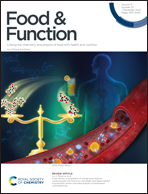Daphnetin contributes to allergen-induced Th2 cytokine expression and type 2-immune responses in atopic dermatitis and asthma†
Abstract
Daphne koreana Nakai is a cherished medicinal plant in the Changbai Mountain region of China. It can be incorporated into medicinal meals and used for various skin diseases by infiltrating liquor. Daphnetin (7,8-dihydroxycoumarin, Dap.) is a main constituent of D. koreana Nakai, which has been used to treat inflammatory conditions and immune disorders due to its numerous pharmacological activities, including anti-oxidant, anti-inflammatory, analgesic, etc. Atopic dermatitis (AD) and allergic asthma are typical diseases of type 2-immune responses. In the present study, the therapeutic potential of Dap. against AD and allergic asthma was investigated using animal and cell experiments. AD-like lesions were induced by repeated application of 1-chloro-2,4-dinitrobenzene (DNCB) to the shaved dorsal skin of BALB/c mice. Ovalbumin (OVA) induction was utilized to establish a mouse asthma model. A passive cutaneous anaphylaxis (PCA) mouse ear model and immunoglobulin E (IgE)/bovine serum albumin (BSA)-stimulated RBL-2H3 cells were used for in vitro assays. The skin lesions and serum and tissue homogenates of the mice were analyzed using histological analysis, immunohistochemistry (IHC) and enzyme-linked immunosorbent assay (ELISA), respectively, in order to investigate the anti-AD effects of Dap. Histological analysis was performed on the allergic asthma model to observe inflammatory cell infiltration in the lung tissues. Total IgE and OVA-specific IgE in the serum were measured by ELISA. The levels of inflammatory cytokines in BALF were detected by ELISA. In addition, ELISA and western blotting were performed for the in vitro analysis of RBL-2H3 cells. The results showed that Dap. inhibited the development of DNCB-induced AD-like lesions in the BALB/c mice by reducing the severity of the lesions, epidermal thickness and mast cell infiltration; this was accompanied by reduced levels of IgE and inflammatory cytokines [interleukin (IL)-4, IL-5, IL-9, IL-13, IL-33 and thymic stromal lymphopoietin (TSLP)]. In the allergic asthma model, Dap. reduced the number of infiltrated inflammatory cells in the lung tissues. Moreover, the levels of total serum IgE and OVA-specific IgE were reduced in the high daphnetin dose groups (Dap., −100 mg kg−1). Dap. administered at a dose of −100 mg kg−1 decreased the levels of inflammatory cytokines (IL-4, IL-5, IL-9, IL-13, IL-33 and TSLP in BALF). Furthermore, Dap. administered to IgE-sensitized mice effectively attenuated the IgE-triggered PCA reaction. In vitro, Dap. decreased the expression levels of histamine, IL-4, IL-6, IL-13, MIP-1α and INF-α, and reduced the protein expression levels of phosphorylated MAPKs, P-Lyn and P-syk in the RBL-2H3 cells. Therefore, Dap. can be represented as a potential therapeutic strategy for the treatment of allergic inflammatory conditions via immunoregulation.



 Please wait while we load your content...
Please wait while we load your content...